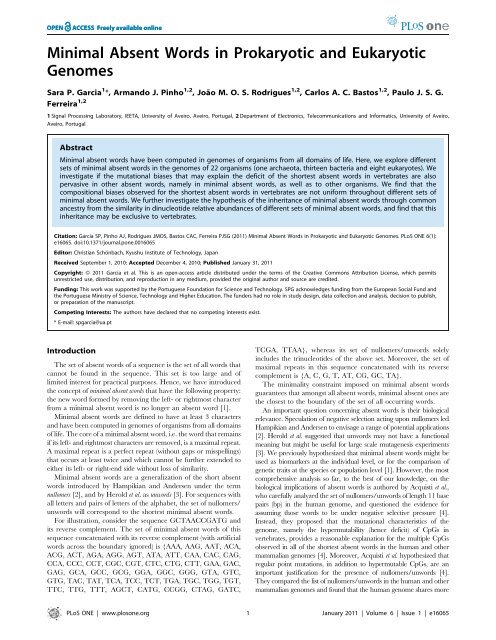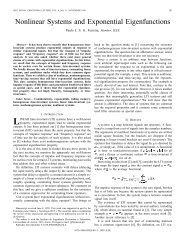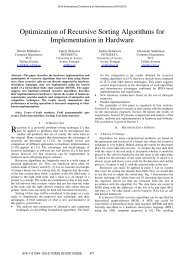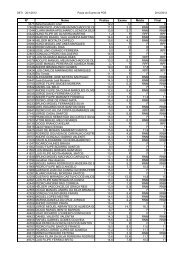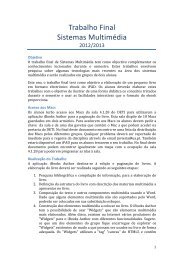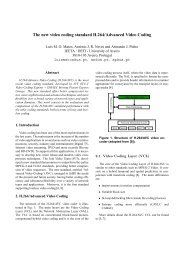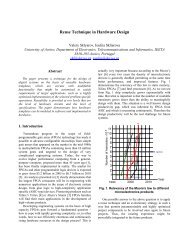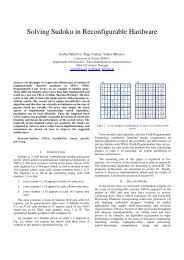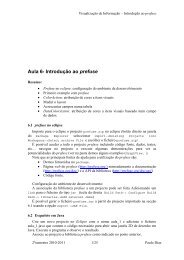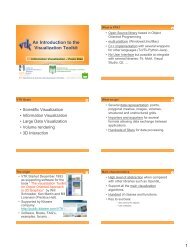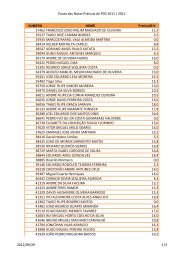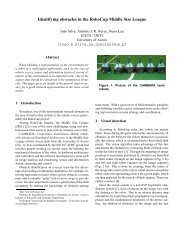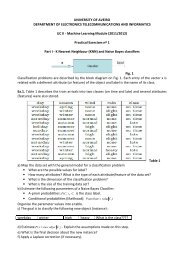Minimal Absent Words in Prokaryotic and Eukaryotic Genomes - Sweet
Minimal Absent Words in Prokaryotic and Eukaryotic Genomes - Sweet
Minimal Absent Words in Prokaryotic and Eukaryotic Genomes - Sweet
You also want an ePaper? Increase the reach of your titles
YUMPU automatically turns print PDFs into web optimized ePapers that Google loves.
<strong>M<strong>in</strong>imal</strong> <strong>Absent</strong> <strong>Words</strong> <strong>in</strong> <strong>Prokaryotic</strong> <strong>and</strong> <strong>Eukaryotic</strong><br />
<strong>Genomes</strong><br />
Sara P. Garcia 1 *, Arm<strong>and</strong>o J. P<strong>in</strong>ho 1,2 , João M. O. S. Rodrigues 1,2 , Carlos A. C. Bastos 1,2 , Paulo J. S. G.<br />
Ferreira 1,2<br />
1 Signal Process<strong>in</strong>g Laboratory, IEETA, University of Aveiro, Aveiro, Portugal, 2 Department of Electronics, Telecommunications <strong>and</strong> Informatics, University of Aveiro,<br />
Aveiro, Portugal<br />
Abstract<br />
<strong>M<strong>in</strong>imal</strong> absent words have been computed <strong>in</strong> genomes of organisms from all doma<strong>in</strong>s of life. Here, we explore different<br />
sets of m<strong>in</strong>imal absent words <strong>in</strong> the genomes of 22 organisms (one archaeota, thirteen bacteria <strong>and</strong> eight eukaryotes). We<br />
<strong>in</strong>vestigate if the mutational biases that may expla<strong>in</strong> the deficit of the shortest absent words <strong>in</strong> vertebrates are also<br />
pervasive <strong>in</strong> other absent words, namely <strong>in</strong> m<strong>in</strong>imal absent words, as well as to other organisms. We f<strong>in</strong>d that the<br />
compositional biases observed for the shortest absent words <strong>in</strong> vertebrates are not uniform throughout different sets of<br />
m<strong>in</strong>imal absent words. We further <strong>in</strong>vestigate the hypothesis of the <strong>in</strong>heritance of m<strong>in</strong>imal absent words through common<br />
ancestry from the similarity <strong>in</strong> d<strong>in</strong>ucleotide relative abundances of different sets of m<strong>in</strong>imal absent words, <strong>and</strong> f<strong>in</strong>d that this<br />
<strong>in</strong>heritance may be exclusive to vertebrates.<br />
Citation: Garcia SP, P<strong>in</strong>ho AJ, Rodrigues JMOS, Bastos CAC, Ferreira PJSG (2011) <strong>M<strong>in</strong>imal</strong> <strong>Absent</strong> <strong>Words</strong> <strong>in</strong> <strong>Prokaryotic</strong> <strong>and</strong> <strong>Eukaryotic</strong> <strong>Genomes</strong>. PLoS ONE 6(1):<br />
e16065. doi:10.1371/journal.pone.0016065<br />
Editor: Christian Schönbach, Kyushu Institute of Technology, Japan<br />
Received September 1, 2010; Accepted December 4, 2010; Published January 31, 2011<br />
Copyright: ß 2011 Garcia et al. This is an open-access article distributed under the terms of the Creative Commons Attribution License, which permits<br />
unrestricted use, distribution, <strong>and</strong> reproduction <strong>in</strong> any medium, provided the orig<strong>in</strong>al author <strong>and</strong> source are credited.<br />
Fund<strong>in</strong>g: This work was supported by the Portuguese Foundation for Science <strong>and</strong> Technology. SPG acknowledges fund<strong>in</strong>g from the European Social Fund <strong>and</strong><br />
the Portuguese M<strong>in</strong>istry of Science, Technology <strong>and</strong> Higher Education. The funders had no role <strong>in</strong> study design, data collection <strong>and</strong> analysis, decision to publish,<br />
or preparation of the manuscript.<br />
Compet<strong>in</strong>g Interests: The authors have declared that no compet<strong>in</strong>g <strong>in</strong>terests exist.<br />
* E-mail: spgarcia@ua.pt<br />
Introduction<br />
The set of absent words of a sequence is the set of all words that<br />
cannot be found <strong>in</strong> the sequence. This set is too large <strong>and</strong> of<br />
limited <strong>in</strong>terest for practical purposes. Hence, we have <strong>in</strong>troduced<br />
the concept of m<strong>in</strong>imal absent words that have the follow<strong>in</strong>g property:<br />
the new word formed by remov<strong>in</strong>g the left- or rightmost character<br />
from a m<strong>in</strong>imal absent word is no longer an absent word [1].<br />
<strong>M<strong>in</strong>imal</strong> absent words are def<strong>in</strong>ed to have at least 3 characters<br />
<strong>and</strong> have been computed <strong>in</strong> genomes of organisms from all doma<strong>in</strong>s<br />
of life. The core of a m<strong>in</strong>imal absent word, i.e. the word that rema<strong>in</strong>s<br />
if its left- <strong>and</strong> rightmost characters are removed, is a maximal repeat.<br />
A maximal repeat is a perfect repeat (without gaps or misspell<strong>in</strong>gs)<br />
that occurs at least twice <strong>and</strong> which cannot be further extended to<br />
either its left- or right-end side without loss of similarity.<br />
<strong>M<strong>in</strong>imal</strong> absent words are a generalization of the short absent<br />
words <strong>in</strong>troduced by Hampikian <strong>and</strong> Andersen under the term<br />
nullomers [2], <strong>and</strong> by Herold et al. as unwords [3]. For sequences with<br />
all letters <strong>and</strong> pairs of letters of the alphabet, the set of nullomers/<br />
unwords will correspond to the shortest m<strong>in</strong>imal absent words.<br />
For illustration, consider the sequence GCTAACCGATG <strong>and</strong><br />
its reverse complement. The set of m<strong>in</strong>imal absent words of this<br />
sequence concatenated with its reverse complement (with artificial<br />
words across the boundary ignored) is {AAA, AAG, AAT, ACA,<br />
ACG, ACT, AGA, AGG, AGT, ATA, ATT, CAA, CAC, CAG,<br />
CCA, CCC, CCT, CGC, CGT, CTC, CTG, CTT, GAA, GAC,<br />
GAG, GCA, GCC, GCG, GGA, GGC, GGG, GTA, GTC,<br />
GTG, TAC, TAT, TCA, TCC, TCT, TGA, TGC, TGG, TGT,<br />
TTC, TTG, TTT, AGCT, CATG, CCGG, CTAG, GATC,<br />
TCGA, TTAA}, whereas its set of nullomers/unwords solely<br />
<strong>in</strong>cludes the tr<strong>in</strong>ucleotides of the above set. Moreover, the set of<br />
maximal repeats <strong>in</strong> this sequence concatenated with its reverse<br />
complement is {A, C, G, T, AT, CG, GC, TA}.<br />
The m<strong>in</strong>imality constra<strong>in</strong>t imposed on m<strong>in</strong>imal absent words<br />
guarantees that amongst all absent words, m<strong>in</strong>imal absent ones are<br />
the closest to the boundary of the set of all occurr<strong>in</strong>g words.<br />
An important question concern<strong>in</strong>g absent words is their biological<br />
relevance. Speculation of negative selection act<strong>in</strong>g upon nullomers led<br />
Hampikian <strong>and</strong> Andersen to envisage a range of potential applications<br />
[2]. Herold et al. suggested that unwords may not have a functional<br />
mean<strong>in</strong>g but might be useful for large scale mutagenesis experiments<br />
[3]. We previously hypothesized that m<strong>in</strong>imal absent words might be<br />
used as biomarkers at the <strong>in</strong>dividual level, or for the comparison of<br />
genetic traits at the species or population level [1]. However, the most<br />
comprehensive analysis so far, to the best of our knowledge, on the<br />
biological implications of absent words is authored by Acquisti et al.,<br />
who carefully analyzed the set of nullomers/unwords of length 11 base<br />
pairs (bp) <strong>in</strong> the human genome, <strong>and</strong> questioned the evidence for<br />
assum<strong>in</strong>g those words to be under negative selective pressure [4].<br />
Instead, they proposed that the mutational characteristics of the<br />
genome, namely the hypermutability (hence deficit) of CpGs <strong>in</strong><br />
vertebrates, provides a reasonable explanation for the multiple CpGs<br />
observed <strong>in</strong> all of the shortest absent words <strong>in</strong> the human <strong>and</strong> other<br />
mammalian genomes [4]. Moreover, Acquisti et al. hypothesized that<br />
regular po<strong>in</strong>t mutations, <strong>in</strong> addition to hypermutable CpGs, are an<br />
important justification for the presence of nullomers/unwords [4].<br />
They compared the list of nullomers/unwords <strong>in</strong> the human <strong>and</strong> other<br />
mammalian genomes <strong>and</strong> found that the human genome shares more<br />
PLoS ONE | www.plosone.org 1 January 2011 | Volume 6 | Issue 1 | e16065
<strong>M<strong>in</strong>imal</strong> <strong>Absent</strong> <strong>Words</strong> <strong>in</strong> <strong>Genomes</strong><br />
nullomers/unwords with its closest evolutionary relative, the chimpanzee,<br />
than with more distantly related mammals, hence suggest<strong>in</strong>g<br />
that the set of human nullomers/unwords conta<strong>in</strong>s nullomers/unwords<br />
<strong>in</strong>herited from the common ancestor of human <strong>and</strong> chimpanzee, <strong>in</strong><br />
addition to those that have arisen with<strong>in</strong> the human l<strong>in</strong>eage [4].<br />
Here, we complement their analysis by <strong>in</strong>vestigat<strong>in</strong>g if the<br />
compositional biases that may expla<strong>in</strong> the deficit of the shortest<br />
absent words <strong>in</strong> vertebrates are also pervasive <strong>in</strong> other absent<br />
words, namely, <strong>in</strong> m<strong>in</strong>imal absent words. Moreover, we compare<br />
sets of m<strong>in</strong>imal absent words, <strong>and</strong> respective compositional biases,<br />
<strong>in</strong> organisms other than vertebrates. We further <strong>in</strong>vestigate the<br />
hypothesis of the <strong>in</strong>heritance of m<strong>in</strong>imal absent words through<br />
common ancestry, <strong>in</strong> addition to l<strong>in</strong>eage specific <strong>in</strong>heritance, from<br />
the similarity <strong>in</strong> d<strong>in</strong>ucleotide compositional biases of different sets<br />
of m<strong>in</strong>imal absent words. For estimat<strong>in</strong>g the compositional biases,<br />
we use the methodology of d<strong>in</strong>ucleotide relative abundances<br />
pioneered by Brendel et al. [5], Pietrokovski et al. [6], <strong>and</strong> Karl<strong>in</strong><br />
<strong>and</strong> collaborators (e.g. [7–9]).<br />
Methods<br />
Genomic data<br />
We considered the genomes of one archaeota, thirteen bacteria<br />
<strong>and</strong> eight case-study eukaryotes (Table 1) as available from the<br />
NCBI database [10], the Saccharomyces Genome Database [11], the<br />
database <strong>in</strong> The Arabidopsis Information Resource [12], the<br />
WormBase database [13], <strong>and</strong> the FlyBase database [14]. For<br />
convenience, the scientific names <strong>in</strong> figures <strong>and</strong> tables are<br />
abbreviated to the first letter of the genus followed by the first<br />
letter of the epithet. Two exceptions <strong>in</strong>clude two additional letters<br />
as prefixes, namely for the methicill<strong>in</strong>-resistant Staphylococcus aureus<br />
(MRSa) <strong>and</strong> the methicill<strong>in</strong>-susceptible Staphylococcus aureus (MSSa).<br />
The reference assemblies of the reported NCBI builds are used for<br />
the chicken, mouse, chimpanzee <strong>and</strong> human genomes.<br />
F<strong>in</strong>d<strong>in</strong>g m<strong>in</strong>imal absent words<br />
Consider a f<strong>in</strong>ite alphabet S with card<strong>in</strong>ality jSj. Let jSj denote<br />
the length of a str<strong>in</strong>g S over S <strong>and</strong> S½pŠ its p th character, with<br />
1ƒpƒjSj. A substr<strong>in</strong>g of S start<strong>in</strong>g at position p 1 <strong>and</strong> end<strong>in</strong>g at<br />
position p 2 is denoted by S½p 1 ::p 2 Š, with p 1 ƒp 2 .Ifp 1 ~p 2 ~p,<br />
then S½p::pŠ:S½pŠ. Moreover, lS (Sr) denotes the concatenation of<br />
character l (r) to the left (right) end side of S, with l,r [ S.<br />
Let a denote a substr<strong>in</strong>g of S <strong>and</strong> P a denote the set of<br />
positions of a <strong>in</strong> S, i.e. S½p::pzjaj{1Š~a,Vp [ P a <strong>and</strong><br />
S½p::pzjaj{1Š=a,Vp 6[ P a . A maximal repeated pair <strong>in</strong> S is a<br />
pair of identical substr<strong>in</strong>gs such that the character to the<br />
immediate left (right) of one of the substr<strong>in</strong>gs is different from<br />
the character to the immediate left (right) of the other substr<strong>in</strong>g,<br />
i.e. a triple (p 1 ,p 2 ,a), such that p 1 = p 2 , S½p 1 {1Š=S½p 2 {1Š <strong>and</strong><br />
S½p 1 zjajŠ=S½p 2 zjajŠ, with p 1 ,p 2 [ P a [15]. A substr<strong>in</strong>g a is a<br />
Table 1. Genomic data.<br />
Organism Abbreviation Genome reference<br />
Euryarchaeota<br />
Methanococcus jannaschii stra<strong>in</strong> DSM2661 Mj NC000909<br />
Bacteria<br />
Bacillus anthracis stra<strong>in</strong> Ames Ba NC003997<br />
Bacillus subtilis stra<strong>in</strong> 168 Bs NC000964<br />
Escherichia coli stra<strong>in</strong> K-12 substra<strong>in</strong> MG1655 Ec NC000913<br />
Haemophilus <strong>in</strong>fluenzae stra<strong>in</strong> Rd KW20 Hi NC000907<br />
Helicobacter pylori stra<strong>in</strong> 26695 Hp NC000915<br />
Lactobacillus casei stra<strong>in</strong> BL23 Lc NC010999<br />
Lactococcus lactis stra<strong>in</strong> Il1403 Ll NC002662<br />
Mycoplasma genitalium stra<strong>in</strong> G37 Mg NC000908<br />
Staphylococcus aureus stra<strong>in</strong> N315 Sa NC002745<br />
methicill<strong>in</strong>-resistant Staphylococcus aureus stra<strong>in</strong> 252 MRSa NC002952<br />
methicill<strong>in</strong>-susceptible Staphylococcus aureus stra<strong>in</strong> 476 MSSa NC002953<br />
Streptococcus pneumoniae stra<strong>in</strong> CGSP14 Sp NC010582<br />
Xanthomonas campestris stra<strong>in</strong> 8004 Xc NC007086<br />
Eukaryotes<br />
Saccharomyces cerevisiae stra<strong>in</strong> S228C (budd<strong>in</strong>g yeast) Sc SGD release 1<br />
Arabidopsis thaliana (thale cress) At AGI release 7.2<br />
Caenorhabditis elegans (worm) Ce WormBase release 170<br />
Drosophila melanogaster (fruit fly) Dm FlyBase release 5<br />
Gallus gallus (chicken) Gg build 2.1<br />
Mus musculus (mouse) Mm build 37.1<br />
Pan troglodytes (chimpanzee) Pt build 2.1<br />
Homo sapiens (human) Hs build 36.3<br />
Organisms selected for this study, with reference to the respective abbreviation, <strong>and</strong> identification of genome sequence data by accession number (euryarchaeota <strong>and</strong><br />
bacteria) or genome assembly project (eukaryotes).<br />
doi:10.1371/journal.pone.0016065.t001<br />
PLoS ONE | www.plosone.org 2 January 2011 | Volume 6 | Issue 1 | e16065
<strong>M<strong>in</strong>imal</strong> <strong>Absent</strong> <strong>Words</strong> <strong>in</strong> <strong>Genomes</strong><br />
maximal repeat <strong>in</strong> S if it occurs <strong>in</strong> a maximal pair, i.e. if there is at<br />
least a maximal repeated pair <strong>in</strong> S of the form (p 1 ,p 2 ,a), with<br />
S½p 1 ::p 1 zjaj{1Š~S½p 2 ::p 2 zjaj{1Š~a [15].<br />
A str<strong>in</strong>g c~lar is a m<strong>in</strong>imal absent word of S if <strong>and</strong> only if c is<br />
not a substr<strong>in</strong>g of S, but la~c½1::jcj{1Š <strong>and</strong> ar~c½2::jcjŠ are<br />
substr<strong>in</strong>gs of S. For convenience, we consider jcj§3.<br />
Theorem 1. (proof <strong>in</strong> [1]) If c~lar is a m<strong>in</strong>imal absent word of S,<br />
then a is a maximal repeat <strong>in</strong> S.<br />
Theorem 2. (proof <strong>in</strong> [1]) A str<strong>in</strong>g c~lar is a m<strong>in</strong>imal absent word of<br />
S if <strong>and</strong> only if (l,r) [ L a |R a but (l,r) 6[ E a , where L a ~f l [ S :<br />
la is a substr<strong>in</strong>g of Sg , R a ~f r [ S : ar isasubstr<strong>in</strong>gof Sg <strong>and</strong><br />
E a ~f (l,r) [ S|S : lar isasubstr<strong>in</strong>gof Sg .<br />
If c~lar is a m<strong>in</strong>imal absent word of S, then a occurs at<br />
least twice <strong>in</strong> S <strong>and</strong> these occurrences may partially overlap. It is<br />
easily verifiable that, as jSj~4 <strong>in</strong> DNA sequences, the maximum<br />
number of m<strong>in</strong>imal absent words associated to a particular a is<br />
twelve, <strong>and</strong> it occurs when E a ~f(l 1 ,r 1 ),(l 2 ,r 2 ),(l 3 ,r 3 ),(l 4 ,r 4 )g, with<br />
l i =l j <strong>and</strong> r i =r j ,Vi=j. This property implies that frequent repeats<br />
have a high probability of not generat<strong>in</strong>g m<strong>in</strong>imal absent words,<br />
because for those frequent repeats E a is often equal to S|S.<br />
<strong>M<strong>in</strong>imal</strong> absent words are found by read<strong>in</strong>g the <strong>in</strong>formation <strong>in</strong> a<br />
suffix array. A suffix array is an array of <strong>in</strong>tegers p k , with<br />
1ƒp k ƒjSj <strong>and</strong> 1ƒkƒjSj, each po<strong>in</strong>t<strong>in</strong>g to the beg<strong>in</strong>n<strong>in</strong>g of a<br />
suffix of S, such that S½p i ::jSjŠ lexicographically precedes<br />
S½p j ::jSjŠ,Vivj. Two auxiliary arrays are used, namely, the longest<br />
common prefix (lcp) array, <strong>and</strong> the left character (bwt) array, the<br />
latter correspond<strong>in</strong>g to the Burrows <strong>and</strong> Wheeler transform [16].<br />
The lcp-array conta<strong>in</strong>s the lengths of the longest common prefix<br />
between consecutive ordered suffixes, i.e. lcp k <strong>in</strong>dicates the length of<br />
the longest common prefix between S½p k{1 ::jSjŠ <strong>and</strong> S½p k ::jSjŠ,<br />
with 2ƒkƒjSj. By convention, lcp 1 ~lcp jSjz1 ~0. The bwt-array<br />
is a permutation of S such that bwt k ~S½p k {1Š if p k w1, <strong>and</strong>,by<br />
convention, bwt k ~# if p k ~1, where # is a character that does not<br />
belong to the alphabet S. Conceptually, the bwt-array does not<br />
provide any additional <strong>in</strong>formation, as the left character of any<br />
character of S can be determ<strong>in</strong>ed by direct access to S. However,<br />
the bwt-array allows for sequential memory access, hence<br />
improv<strong>in</strong>g the performance due to enhanced use of cache [17].<br />
The first part of the algorithm generates all lcp-<strong>in</strong>tervals us<strong>in</strong>g the<br />
lcp-array <strong>and</strong> a stack, <strong>and</strong> is adapted from [18] <strong>and</strong> [17]. An lcp<strong>in</strong>terval<br />
of lcp-depth d is the <strong>in</strong>terval ½i::jŠ, with1ƒivjƒjSj, if<strong>and</strong><br />
only if lcp i vd; lcp k §d,Vivkƒj; lcp k ~d, foratleastonek <strong>in</strong><br />
ivkƒj;<strong>and</strong>lcp jz1 vd. Each lcp-<strong>in</strong>terval delimits a subset of suffixes<br />
that start with a common d-letter prefix a~S½p k ::p k zd{1Š,<br />
V k : iƒkƒj. The second part of the algorithm determ<strong>in</strong>es if an lcp<strong>in</strong>terval<br />
is left-diverse, i.e. if at least two characters of bwt k differ, for<br />
iƒkƒj. Inthatcase,a~S½p i ::p i zd{1Š is a maximal repeat, as all<br />
substr<strong>in</strong>gs S½p k ::p k zd{1Š are identical, Viƒkƒj.Fromthesemaximal<br />
repeats, all m<strong>in</strong>imal absent words associated to each lcp-<strong>in</strong>terval<br />
are computed <strong>and</strong> then output. See [1] for details on the algorithm.<br />
Sets of m<strong>in</strong>imal absent words are found by concatenat<strong>in</strong>g the<br />
genome with its reverse complement us<strong>in</strong>g a delimit<strong>in</strong>g character<br />
Figure 1. Number of m<strong>in</strong>imal absent words <strong>in</strong> genomic sequences:. Distributions of the number of m<strong>in</strong>imal absent words (MAWs) <strong>in</strong> the<br />
genomes of selected organisms for word length up to 50.<br />
M 11 M 14<br />
M 17 M 24<br />
doi:10.1371/journal.pone.0016065.g001<br />
PLoS ONE | www.plosone.org 3 January 2011 | Volume 6 | Issue 1 | e16065
<strong>M<strong>in</strong>imal</strong> <strong>Absent</strong> <strong>Words</strong> <strong>in</strong> <strong>Genomes</strong><br />
that does not belong to the alphabet, to avoid the formation of<br />
artificial words across boundaries. The order by which the<br />
chromosomes are <strong>in</strong>serted is irrelevant. We solely consider<br />
unambiguous nucleotides (A, C, G or T) <strong>and</strong> have ignored all<br />
sequence ambiguities by replac<strong>in</strong>g every subsequence of ambiguously<br />
sequenced nucleotides (e.g. K, M, N, R, S, W <strong>and</strong> Y) with a<br />
delimit<strong>in</strong>g character that does not belong to the alphabet.<br />
Compositional biases from d<strong>in</strong>ucleotide relative<br />
abundances<br />
Let f X denote the relative frequency of nucleotide X <strong>in</strong> a given<br />
genomic sequence, <strong>and</strong> f XY the relative frequency of d<strong>in</strong>ucleotide XY.<br />
A st<strong>and</strong>ard assessment of nucleotide bias is through the odds-ratio<br />
r XY ~ f XY<br />
,<br />
ð1Þ<br />
f X f Y<br />
with r XY values sufficiently larger (smaller) than one imply<strong>in</strong>g that the<br />
XY d<strong>in</strong>ucleotide is considered of high (low) relative abundance<br />
compared to a r<strong>and</strong>om association of its component mononucleotides<br />
[19].<br />
For double-str<strong>and</strong>ed DNA molecules, (1) must be modified <strong>in</strong><br />
order to account for the <strong>in</strong>herent complementary anti-parallel<br />
structure. Let S ~SzS T def<strong>in</strong>e the str<strong>in</strong>g result<strong>in</strong>g from<br />
comb<strong>in</strong><strong>in</strong>g the DNA sequence S with its reverse complement S T .<br />
In S , the analogous str<strong>and</strong> symmetric functionals for the base<br />
frequencies are now<br />
f A ~ f Azf T<br />
2<br />
~fT <strong>and</strong> f C ~ f Czf G<br />
~fG 2<br />
,<br />
with f A ~n A =N, where n A is the number of aden<strong>in</strong>e (A) nucleotides<br />
<strong>in</strong> a sequence of length N, with equivalent formulas for cytos<strong>in</strong>e (C),<br />
guan<strong>in</strong>e (G), <strong>and</strong> thym<strong>in</strong>e (T). The analogous str<strong>and</strong> symmetric<br />
functionals for the d<strong>in</strong>ucleotide odds-ratio are now<br />
an example be<strong>in</strong>g<br />
with<br />
r XY ~ f XY<br />
<br />
fX f Y<br />
, ð2Þ<br />
r AC ~ f AC<br />
<br />
fA f C<br />
~ 2(f ACzf GT )<br />
(f A zf T )(f C zf G ) ~ f GT<br />
<br />
fG f T<br />
~r GT ,<br />
fAC ~ f ACzf GT<br />
~fGT 2<br />
,<br />
<strong>and</strong> f AC ~n AC =(N{1), where n AC is the number of AC<br />
d<strong>in</strong>ucleotides <strong>in</strong> a sequence of length N, with equivalent formulas<br />
for all other d<strong>in</strong>ucleotides. The total number of d<strong>in</strong>ucleotides <strong>in</strong> a set<br />
with card<strong>in</strong>ality Z of m<strong>in</strong>imal absent words of word length w is<br />
Z|(w{1). The vector of r values has remarkably low variance<br />
Table 2. Compositional biases.<br />
Genome M 11 M 14 M 17 M 24<br />
Size (bp) G+C Size G+C Size G+C Size G+C Size G+C<br />
Ba 5,227,293 0.36 873,180 0.56 4,485,825 0.32 330,770 0.26 694 0.36<br />
Bs 4,214,630 0.44 935,554 0.54 3,089,102 0.40 126,496 0.36 162 0.40<br />
Ec 4,639,675 0.50 839,014 0.50 3,504,611 0.52 141,556 0.54 702 0.54<br />
Hi 1,830,023 0.38 888,594 0.48 947,347 0.32 43,098 0.32 312 0.38<br />
Hp 1,667,825 0.38 722,762 0.48 943,139 0.36 71,452 0.32 218 0.36<br />
Lc 3,079,196 0.46 1,048,894 0.52 1,715,556 0.44 49,896 0.44 630 0.54<br />
Ll 2,365,589 0.36 919,156 0.50 1,446,921 0.30 93,684 0.26 516 0.28<br />
Mj 1,664,957 0.32 539,920 0.46 1,051,171 0.28 96,626 0.22 428 0.32<br />
Mg 580,076 0.32 391,682 0.40 215,544 0.26 10,658 0.24 66 0.42<br />
Sa 2,814,816 0.32 852,402 0.50 1,969,819 0.28 123,642 0.24 362 0.34<br />
MRSa 2,902,619 0.32 852,542 0.50 1,988,247 0.28 131,756 0.24 354 0.34<br />
MSSa 2,799,802 0.32 851,978 0.50 1,988,247 0.28 126,348 0.22 418 0.36<br />
Sp 2,209,198 0.40 1,019,764 0.50 1,078,877 0.36 39,170 0.32 576 0.38<br />
Xc 5,148,708 0.64 853,780 0.48 3,936,720 0.66 642,460 0.72 1,762 0.66<br />
Sc 12,739,648 0.38 423,500 0.64 12,398,033 0.38 901,182 0.28 5,619 0.20<br />
At 118,973,747 0.36 22,900 0.80 56,034,743 0.48 56,311,864 0.30 363,823 0.28<br />
Ce 100,269,917 0.36 7,668 0.70 53,359,766 0.48 43,423,752 0.30 648,884 0.28<br />
Dm 162,348,295 0.42 104 0.70 74,357,742 0.50 54,260,892 0.36 506,678 0.34<br />
Gg 984,856,238 0.42 700 0.60 38,646,642 0.56 1,006,332,266 0.42 6,768,820 0.36<br />
Mm 2,559,165,832 0.42 190 0.62 26,244,051 0.56 1,788,521,026 0.44 47,781,970 0.40<br />
Pt 2,752,354,403 0.40 116 0.62 26,194,501 0.56 1,767,172,092 0.44 58,934,573 0.36<br />
Hs 2,858,029,377 0.40 104 0.60 25,778,756 0.56 1,788,484,146 0.44 61,816,985 0.36<br />
GC content (G+C) <strong>and</strong> total (haploid) genome size <strong>in</strong> units of base pairs (bp) for selected genomes, followed by the GC content <strong>and</strong> total number of words (size) <strong>in</strong> sets<br />
of m<strong>in</strong>imal absent words of word length 11 (M 11 ), 14 (M 14 ), 17 (M 17 ) <strong>and</strong> 24 (M 24 ).<br />
doi:10.1371/journal.pone.0016065.t002<br />
PLoS ONE | www.plosone.org 4 January 2011 | Volume 6 | Issue 1 | e16065
<strong>M<strong>in</strong>imal</strong> <strong>Absent</strong> <strong>Words</strong> <strong>in</strong> <strong>Genomes</strong><br />
Table 3. D<strong>in</strong>ucleotide relative abundances.<br />
TT GT CT TG GG TC TT GT CT TG GG TC<br />
AA AC AG AT CA CC CG GA GC TA AA AC AG AT CA CC CG GA GC TA<br />
M11 M14<br />
Ba 0.8674 1.0829 1.0923 0.9579 1.0367 0.9270 0.9426 1.0532 0.9268 1.0778 1.1632 0.8850 0.9131 0.9778 1.0685 0.9252 0.9343 0.9982 1.1398 0.8450<br />
Bs 0.8389 1.1625 1.0671 0.9096 0.9544 0.9941 0.9771 0.9754 0.8734 1.2592 1.3249 0.6594 0.8978 1.0097 1.1116 0.9227 1.0001 1.0920 1.3769 0.5639<br />
Ec 0.8653 1.0761 1.1074 0.9460 0.9447 1.0551 0.8959 1.0539 0.8099 1.1434 1.2753 0.8326 0.7758 1.1317 1.1428 0.8806 1.2016 0.8909 1.3901 0.6799<br />
Hi 0.9717 1.0392 1.0115 1.0223 1.0561 0.8915 0.9939 0.9865 1.0328 1.0298 1.3343 0.7593 0.7542 0.9443 1.1501 1.0040 1.0393 0.8656 1.5976 0.6944<br />
Hp 0.9999 0.8946 1.0342 1.1011 1.0897 0.9942 0.8301 0.9418 1.1336 1.0129 1.4790 0.5966 0.9617 0.8030 0.9171 1.1756 0.9360 0.8583 1.6716 0.6833<br />
Lc 0.8694 1.0764 1.0688 0.9881 0.9256 0.9919 1.0015 1.0188 0.9064 1.2046 1.3264 0.7931 0.7564 1.0573 1.2951 0.8888 1.0202 0.9474 1.4023 0.4950<br />
Ll 0.9394 1.0483 1.0543 1.0123 1.0562 0.9297 0.9069 1.0110 0.9543 1.0446 1.3057 0.7430 0.9376 0.8808 1.1690 0.9871 0.5607 1.0806 1.1910 0.6240<br />
Mj 1.0080 0.9651 1.0950 1.0086 1.1583 1.0592 0.5254 0.9743 0.9255 0.9509 1.1675 0.6589 1.1160 0.9607 0.9928 1.3265 0.1362 1.0894 1.0554 0.8397<br />
Mg 1.0729 0.9656 1.0820 0.9640 1.1730 1.0249 0.4096 0.9425 0.9614 0.9203 1.3516 0.9641 1.0373 0.6887 1.1480 0.9439 0.2021 0.8445 1.2541 0.6935<br />
Sa 0.9518 1.0724 1.0640 0.9759 1.0598 0.8798 0.9294 1.0273 0.9538 1.0301 1.1225 0.9195 0.8297 1.0227 1.2305 0.8174 0.7703 0.9571 1.2221 0.8439<br />
MRSa 0.9512 1.0725 1.0643 0.9753 1.0583 0.8838 0.9293 1.0283 0.9506 1.0308 1.1228 0.9182 0.8331 1.0222 1.2262 0.8181 0.7731 0.9591 1.2198 0.8442<br />
MSSa 0.9510 1.0714 1.0641 0.9781 1.0582 0.8792 0.9316 1.0292 0.9530 1.0308 1.1229 0.9187 0.8311 1.0221 1.2291 0.8185 0.7690 0.9570 1.2240 0.8440<br />
Sp 0.9238 1.0612 1.0455 1.0114 1.0453 0.9319 0.9319 1.0047 0.9616 1.0690 1.2614 0.7412 1.0843 0.8686 1.1094 1.0437 0.4806 1.1595 1.0175 0.6272<br />
Xc 0.9980 1.0233 1.0372 0.9046 0.9933 1.0837 0.9363 1.0844 0.8420 0.8905 0.9987 0.9314 0.8578 1.2561 1.3101 0.7968 1.1579 0.9357 1.3168 0.3718<br />
Sc 0.7361 1.1548 1.0227 0.9554 0.8656 0.9264 1.1417 1.0688 0.9380 1.3886 1.1430 0.8883 0.9940 0.9657 1.1245 1.0058 0.6842 1.0659 0.9637 0.7815<br />
At 0.6870 1.1120 0.9022 1.0019 0.8643 0.9710 1.1041 0.7442 1.0904 2.4828 0.9740 1.0247 1.0508 0.9970 1.0531 0.9553 0.8830 1.0528 0.9136 0.9670<br />
Ce 0.7467 1.0779 1.1695 0.7336 0.5345 1.0924 1.0418 0.6806 0.9795 3.1638 0.9972 1.0064 1.0168 1.0173 1.0793 0.9359 0.9132 1.0663 0.9413 0.9046<br />
Dm 0.2031 1.4083 1.3361 0.3250 0.1444 1.1315 1.1395 0.5597 0.8185 4.6312 0.9694 1.0001 1.0178 1.0264 1.0255 0.9717 0.9731 1.0342 0.9837 0.9804<br />
Gg 0.7215 1.2696 0.4839 1.3320 0.1294 0.3009 2.7760 1.6576 1.0173 1.7020 0.9875 1.0633 0.8567 1.1065 0.8177 0.9293 1.3506 1.0541 0.9569 1.1795<br />
Mm 0.8047 1.4168 0.0980 1.6093 0.0802 0.1989 3.1720 1.4792 1.1052 2.0116 1.0112 1.1047 0.7685 1.1408 0.7452 0.8347 1.5629 1.0451 1.0283 1.2707<br />
Pt 0.5187 1.4746 0.2044 1.7917 0.0292 0.2080 3.1465 1.7082 0.8499 1.9804 0.9765 1.1250 0.7935 1.1155 0.7496 0.8127 1.5620 1.0659 1.0202 1.2721<br />
Hs 0.6270 1.5013 0.1453 1.5549 0.0969 0.2078 3.1589 1.4529 0.9975 2.3073 0.9770 1.1258 0.7904 1.1168 0.7466 0.8113 1.5697 1.0670 1.0197 1.2732<br />
M17 M24<br />
Ba 1.2532 0.7720 0.9573 0.8747 1.0238 0.9385 0.8698 1.0798 1.2244 0.7420 1.2009 0.8422 0.9177 0.9518 0.8565 1.0275 1.3330 1.0763 1.0910 0.8396<br />
Bs 1.4571 0.5755 0.9314 0.8589 1.0798 0.9053 0.9921 1.1213 1.5339 0.4535 1.2538 0.7191 1.0631 0.8939 1.0631 0.9644 0.8647 1.0943 1.2904 0.6419<br />
Ec 1.3243 0.7623 0.8105 1.1538 1.1810 0.8463 1.1719 0.8565 1.4930 0.6207 1.0957 0.8330 0.8121 1.2909 1.0156 0.8584 1.3054 0.8330 1.4561 1.0463<br />
Hi 1.3925 0.7487 0.7372 0.8735 1.1157 1.0156 1.1798 0.8351 1.7471 0.6578 1.6130 0.8853 0.7172 0.6313 1.0249 1.2034 1.1918 0.6367 1.5788 0.6023<br />
Hp 1.6071 0.5276 1.0325 0.6202 0.7679 1.2301 1.0894 0.8674 1.9277 0.5925 1.4888 0.6517 1.0665 0.6898 0.8469 1.0904 1.0143 0.9968 1.4454 0.6208<br />
Lc 1.3740 0.7606 0.7478 1.0331 1.3132 0.8841 1.0198 0.9273 1.4838 0.4472 1.3225 0.9470 1.0247 0.6921 0.9837 0.9648 1.0462 0.8282 1.2417 0.8722<br />
Ll 1.3628 0.6761 0.9463 0.7994 1.1622 0.9457 0.4694 1.1463 1.2745 0.5643 1.2463 1.1724 1.2465 0.6195 1.2349 0.3842 0.2861 1.1048 0.8257 0.6208<br />
Mj 1.2579 0.5432 1.1750 0.8504 0.8545 1.4438 0.1240 1.1772 1.1479 0.7630 1.3002 0.6199 0.9459 0.9135 0.7801 1.6623 0.9276 1.0307 0.9851 0.7976<br />
Mg 1.3999 0.9789 1.0396 0.6213 1.1343 0.9374 0.1796 0.8249 1.3549 0.6482 1.2241 1.1004 0.9062 0.7949 1.1327 1.3469 0.5563 0.7228 0.8492 0.9062<br />
Sa 1.1715 0.8083 0.8213 0.9710 1.2210 0.8432 0.6931 1.0024 1.4168 0.7926 1.1583 0.8588 0.8889 0.9751 1.2354 1.2402 0.4757 0.9836 1.0193 0.7482<br />
MRSa 1.1749 0.8022 0.8264 0.9672 1.2122 0.8459 0.6956 1.0064 1.4191 0.7918 1.2262 0.8094 0.9032 0.9319 1.2391 1.2731 0.4355 1.0450 0.9464 0.6387<br />
PLoS ONE | www.plosone.org 5 January 2011 | Volume 6 | Issue 1 | e16065
<strong>M<strong>in</strong>imal</strong> <strong>Absent</strong> <strong>Words</strong> <strong>in</strong> <strong>Genomes</strong><br />
Table 3. Cont.<br />
TT GT CT TG GG TC TT GT CT TG GG TC<br />
AA AC AG AT CA CC CG GA GC TA AA AC AG AT CA CC CG GA GC TA<br />
MSSa 1.1734 0.8047 0.8238 0.9691 1.2136 0.8474 0.6976 1.0086 1.4048 0.7913 1.1488 0.7910 0.8930 1.0286 1.2138 1.3481 0.4349 0.9586 1.0972 0.7625<br />
Sp 1.3139 0.6674 1.0855 0.8313 1.0782 1.0787 0.4590 1.2045 1.0577 0.5800 1.1551 0.9672 1.1612 0.7942 1.0862 0.7218 0.8312 1.1224 1.0762 0.7239<br />
Xc 0.8915 0.8372 0.9190 1.5356 1.4737 0.7039 1.1750 0.7927 1.4666 0.2290 1.1805 0.7672 0.8686 1.4490 1.0932 0.8619 1.1768 1.0129 1.2730 0.5404<br />
Sc 1.2873 0.7379 0.9707 0.8648 1.0771 1.0636 0.6238 1.1633 0.9710 0.6474 1.1300 0.7822 0.7601 1.0212 1.0169 1.5590 0.8439 0.8460 1.4507 0.9346<br />
At 1.1882 0.8758 1.0276 0.8891 1.1467 0.9497 0.4811 1.1619 0.7885 0.7090 1.3495 0.7949 1.0314 0.7427 0.9481 1.2108 0.7179 1.1111 0.8849 0.6470<br />
Ce 1.3544 0.8051 0.8595 0.8300 1.1331 0.9660 0.8434 1.1434 0.9442 0.5638 1.6479 0.6363 0.6449 0.6548 0.9278 1.4986 1.4449 0.9360 1.4713 0.4245<br />
Dm 1.3113 0.7948 0.8135 0.9479 1.1792 1.0690 0.8591 0.8354 1.4758 0.7088 1.2507 1.0053 0.7587 0.8966 1.2381 1.0439 0.8886 0.7289 1.3756 0.7875<br />
Gg 1.0517 0.8999 1.2162 0.8893 1.2984 1.0510 0.1728 0.9849 1.0822 0.7658 1.4832 0.7527 1.0513 0.6496 1.1000 1.5054 0.1512 0.9242 1.0100 0.5236<br />
Mm 0.9765 0.9321 1.2167 0.9296 1.2398 1.1517 0.2074 0.9810 0.9470 0.8716 1.2105 0.8866 1.1253 0.7965 1.2101 1.3217 0.1254 0.9683 0.8747 0.6859<br />
Pt 0.9868 0.9224 1.1997 0.9418 1.2328 1.1651 0.2274 0.9730 0.9508 0.8739 1.2579 0.8113 1.0631 0.8358 1.1596 1.3135 0.2443 0.9229 1.0897 0.7115<br />
Hs 0.9852 0.9238 1.1992 0.9420 1.2319 1.1646 0.2330 0.9715 0.9515 0.8765 1.2583 0.8108 1.0642 0.8353 1.1585 1.3157 0.2448 0.9251 1.0834 0.7101<br />
D<strong>in</strong>ucleotide relative abundances for sets of m<strong>in</strong>imal absent words of word length 11 (M11), 14 (M14), 17 (M17) <strong>and</strong> 24 (M24).<br />
doi:10.1371/journal.pone.0016065.t003<br />
throughout the genome of a given organism, <strong>and</strong> can discrim<strong>in</strong>ate<br />
sequences from dist<strong>in</strong>ct organisms [20]. D<strong>in</strong>ucleotide relative<br />
abundances are estimated consider<strong>in</strong>g overlapp<strong>in</strong>g, i.e. word<br />
ACTAC may be segmented <strong>in</strong>to four d<strong>in</strong>ucleotides, namely two<br />
d<strong>in</strong>ucleotides AC, one d<strong>in</strong>ucleotide CT, <strong>and</strong> one d<strong>in</strong>ucleotide TA.<br />
Results <strong>and</strong> Discussion<br />
The total number of m<strong>in</strong>imal absent words <strong>in</strong>creases<br />
with genome size<br />
Figure 1 displays the distributions of the number of m<strong>in</strong>imal<br />
absent words <strong>in</strong> the genomes of selected organisms for <strong>in</strong>creas<strong>in</strong>g<br />
word length. We sampled the distributions at word length 11 (the<br />
result<strong>in</strong>g set of m<strong>in</strong>imal absent words be<strong>in</strong>g designated M 11 ),<br />
which roughly co<strong>in</strong>cides with the beg<strong>in</strong>n<strong>in</strong>g of the curves <strong>and</strong><br />
allows for the comparison with previous studies [4]; at word length<br />
14 (the result<strong>in</strong>g set of m<strong>in</strong>imal absent words be<strong>in</strong>g designated<br />
M 14 ), as it is close to the peak of the distribution for most<br />
prokaryotic genomes surveyed; at word length 17 (the result<strong>in</strong>g set<br />
of m<strong>in</strong>imal absent words be<strong>in</strong>g designated M 17 ), as it is close to<br />
the peak of the distribution for most genomes of higher eukaryotes<br />
surveyed; <strong>and</strong> at word length 24 (the result<strong>in</strong>g set of m<strong>in</strong>imal<br />
absent words be<strong>in</strong>g designated M 24 ) for sampl<strong>in</strong>g the distributions<br />
at the beg<strong>in</strong>n<strong>in</strong>g of the right-end tails. These right-end tails are the<br />
ma<strong>in</strong> differences to profiles obta<strong>in</strong>ed for artificially generated<br />
DNA str<strong>in</strong>gs with a r<strong>and</strong>om distribution of the four unambiguous<br />
nucleotides (A, C, G <strong>and</strong> T) [1].<br />
Compositional biases are not uniform throughout<br />
different sets of m<strong>in</strong>imal absent words<br />
Table 2 reports the GC content (denoted by G+C) of the<br />
genome <strong>and</strong> respective sets of m<strong>in</strong>imal absent words <strong>in</strong> each<br />
organism, with (GzC)~2fC ~2f G <strong>and</strong> 2f A ~2f T ~1{(GzC).<br />
As a consequence of ignor<strong>in</strong>g sequence ambiguities, the f<strong>in</strong>al<br />
(haploid) genome size <strong>in</strong> units of base pairs (bp) may differ slightly<br />
from values commonly reported <strong>in</strong> the literature. We also report<br />
the card<strong>in</strong>ality (size) of each set of m<strong>in</strong>imal absent words, i.e. the<br />
total number of m<strong>in</strong>imal absent words <strong>in</strong> the set. Table 3 displays<br />
the d<strong>in</strong>ucleotide relative abundances of the sets of m<strong>in</strong>imal absent<br />
words <strong>in</strong> the genome of each organism. The reported values are<br />
the str<strong>and</strong> symmetric functionals, with r AA ~r TT denoted by AA<br />
<strong>and</strong> TT, <strong>and</strong> so on. The counts were estimated for each word<br />
separately, <strong>and</strong> cumulative values were estimated over the entire<br />
set.<br />
The compositional biases displayed <strong>in</strong> Tables 2 <strong>and</strong> 3 provide<br />
additional <strong>in</strong>formation for <strong>in</strong>vestigat<strong>in</strong>g the hypothesis of the<br />
hypermutability of CpGs expla<strong>in</strong><strong>in</strong>g the absence of nullomers/<br />
unwords <strong>in</strong> vertebrate genomes, as proposed by Acquisti et al. [4].<br />
We f<strong>in</strong>d that this hypothesis needs revision for longer absent<br />
words, as neither the base nor d<strong>in</strong>ucleotide compositional biases<br />
are uniform throughout sets of m<strong>in</strong>imal absent words of <strong>in</strong>creas<strong>in</strong>g<br />
word length. For example, the d<strong>in</strong>ucleotide CG is overrepresented<br />
<strong>in</strong> sets M 11 <strong>and</strong> M 14 for the vertebrate genomes<br />
considered, but under-represented <strong>in</strong> sets M 17 <strong>and</strong> M 24 . For<br />
quantify<strong>in</strong>g the under- or over-representation of a d<strong>in</strong>ucleotide <strong>in</strong><br />
a given genome, we use the boundaries proposed by Karl<strong>in</strong> <strong>and</strong><br />
collaborators, who proved that a conservative estimate of<br />
r XY ƒ0:78 or r XY §1:23, respectively, occurs for sufficiently long<br />
(§ 5kb) r<strong>and</strong>om sequences, with probability approximately<br />
ƒ0:001, <strong>and</strong> <strong>in</strong>dependent of genome base composition. The<br />
rationale follows that, for a r<strong>and</strong>om sequence, the r XY values p for<br />
all XY approach one, with deviations of about 1= ffiffiffiffi<br />
N for<br />
sequences of length N [21].<br />
PLoS ONE | www.plosone.org 6 January 2011 | Volume 6 | Issue 1 | e16065
<strong>M<strong>in</strong>imal</strong> <strong>Absent</strong> <strong>Words</strong> <strong>in</strong> <strong>Genomes</strong><br />
Figure 2. Similarity <strong>in</strong> d<strong>in</strong>ucleotide compositional biases <strong>in</strong> prokaryotes:. Dendograms from d<strong>in</strong>ucleotide relative abundances <strong>in</strong> sets of<br />
m<strong>in</strong>imal absent words of word length 11 (M 11 ), 14 (M 14 ), 17 (M 17 ) <strong>and</strong> 24 (M 24 ) for selected prokaryotic genomes.<br />
M 11 M 14<br />
M 17 M 24<br />
doi:10.1371/journal.pone.0016065.g002<br />
The <strong>in</strong>heritance of m<strong>in</strong>imal absent words through<br />
common ancestry may be exclusive to vertebrates<br />
Figures 2 <strong>and</strong> 3 display dendograms of the similarity <strong>in</strong><br />
d<strong>in</strong>ucleotide compositional biases amongst organisms <strong>and</strong> throughout<br />
different sets of m<strong>in</strong>imal absent words. Dendograms are<br />
obta<strong>in</strong>ed from matrices with the pairwise Euclidean distances<br />
between dist<strong>in</strong>ct vectors (of length 16) of d<strong>in</strong>ucleotide relative<br />
abundances (r values <strong>in</strong> Table 3), us<strong>in</strong>g the unweighted pair group<br />
method with arithmetic averages (UPGMA, also known as average<br />
l<strong>in</strong>kage method [22]). UPGMA is a simple hierarchical cluster<strong>in</strong>g<br />
method that, by assum<strong>in</strong>g a constant rate of evolution, hence no<br />
implicit evolutionary model, outputs a rooted tree where the sum of<br />
times down a path to the leaves from any node is the same,<br />
regardless of the chosen path. Dendograms were drawn us<strong>in</strong>g the<br />
PHYLIP package [23]. These dendograms based on d<strong>in</strong>ucleotide<br />
relative abundances provide a very useful normalization of often<br />
very differently sized sets of m<strong>in</strong>imal absent words, <strong>and</strong> they are<br />
preferred to dendograms result<strong>in</strong>g from multiple sequence alignments<br />
due to current algorithmic limitations that render practically<br />
<strong>in</strong>feasible to consider such large data sets as those <strong>in</strong> sets M 17 .<br />
The dendograms of similarity <strong>in</strong> d<strong>in</strong>ucleotide relative abundances<br />
displayed <strong>in</strong> Figures 2 <strong>and</strong> 3 often do not recover the correct<br />
PLoS ONE | www.plosone.org 7 January 2011 | Volume 6 | Issue 1 | e16065
<strong>M<strong>in</strong>imal</strong> <strong>Absent</strong> <strong>Words</strong> <strong>in</strong> <strong>Genomes</strong><br />
Figure 3. Similarity <strong>in</strong> d<strong>in</strong>ucleotide compositional biases <strong>in</strong> eukaryotes. Dendograms from d<strong>in</strong>ucleotide relative abundances <strong>in</strong> sets of<br />
m<strong>in</strong>imal absent words of word length 11 (M 11 ), 14 (M 14 ), 17 (M 17 ) <strong>and</strong> 24 (M 24 ) for selected eukaryotic genomes.<br />
doi:10.1371/journal.pone.0016065.g003<br />
phylogenetic relationships, as dendograms based on whole genome<br />
data would, because sets of m<strong>in</strong>imal absent words can have<br />
compositional biases very different from those of the genome<br />
(Table 2). Nevertheless, they are useful for explor<strong>in</strong>g the hypothesis<br />
of the <strong>in</strong>heritance of m<strong>in</strong>imal absent words through a common<br />
ancestor, <strong>in</strong> addition to l<strong>in</strong>eage specific <strong>in</strong>heritance, as proposed by<br />
Acquisti et al. [4] <strong>in</strong> different sets of m<strong>in</strong>imal absent words. We f<strong>in</strong>d<br />
that this hypothesis is not supported by our data for organisms other<br />
than vertebrates, as these represent the only clade whose<br />
phylogenetic relationships are often recovered <strong>in</strong> these dendograms.<br />
As m<strong>in</strong>imal absent words are <strong>in</strong>tr<strong>in</strong>sically related to perfect<br />
repeats, they are closely dependent upon the overall repeats<br />
content <strong>in</strong> the genome, <strong>and</strong> dist<strong>in</strong>ct repeat classes will be<br />
associated to sets of m<strong>in</strong>imal absent words of <strong>in</strong>creas<strong>in</strong>g word<br />
length. The small set of c-proteobacteria considered here (E. coli,<br />
H. <strong>in</strong>fluenzae <strong>and</strong> X. campestris) have, on average, higher GC content<br />
than the e-proteobacterium (H. pylori), the firmicutes (B. anthracis, B.<br />
subtilis, L. casei, L. lactis, M. genitalium, S. aureus, methicill<strong>in</strong>-resistant<br />
S. aureus, methicill<strong>in</strong>-susceptible S. aureus <strong>and</strong> S. pneumoniae), <strong>and</strong><br />
even the euryarchaeota (M. jannaschii). Moreover, though the<br />
genomes of the c-proteobacteria considered here are, on average,<br />
significantly larger than those of the other bacteria, the average<br />
percentage of generic repeats is smaller <strong>in</strong> this phylum than <strong>in</strong> the<br />
others (see [24] for statistics). The bacterium E. coli has one of the<br />
smallest repeat percentages of this set <strong>and</strong> its base compositional<br />
biases vary <strong>in</strong> opposition to the general trend (Table 2). This last<br />
feature is also observed <strong>in</strong> X. campestris, though its GC content is<br />
the highest <strong>in</strong> this set (Table 2), <strong>and</strong> its overall percentage of<br />
repeats is one of the highest.<br />
The similarity <strong>in</strong> d<strong>in</strong>ucleotide relative abundances <strong>in</strong> higher<br />
eukaryotes often recovers the phylogenetic relationships, except <strong>in</strong><br />
set M 11 , where the human is more similar to the more distantly<br />
related mouse than to the evolutionary close chimpanzee<br />
(Figure 3). Apart from the fact that these are extremely small<br />
sets <strong>in</strong> very large genomes (Table 2), we believe part of the<br />
explanation to be related to DNA transposons, which have a<br />
PLoS ONE | www.plosone.org 8 January 2011 | Volume 6 | Issue 1 | e16065
<strong>M<strong>in</strong>imal</strong> <strong>Absent</strong> <strong>Words</strong> <strong>in</strong> <strong>Genomes</strong><br />
significant presence <strong>in</strong> both the mouse <strong>and</strong> human sets M 11 (tough<br />
larger <strong>in</strong> the latter), <strong>and</strong> which are the class of repeats that exists <strong>in</strong><br />
more similar percentage <strong>in</strong> both genomes [25]. The separation of<br />
the worm <strong>and</strong> fruit fly from the metazoan clade may be related to<br />
the more recent orig<strong>in</strong> of repeats <strong>in</strong> the worm <strong>and</strong> fruit fly than<br />
those <strong>in</strong> the rema<strong>in</strong><strong>in</strong>g group (the chicken, mouse, chimpanzee<br />
<strong>and</strong> human), specially <strong>in</strong> the human genome [26].<br />
Conclusions<br />
<strong>M<strong>in</strong>imal</strong> absent words, which are at a m<strong>in</strong>imal distance of a<br />
s<strong>in</strong>gle nucleotide (the left- or rightmost) from be<strong>in</strong>g an observed<br />
word, have been computed <strong>in</strong> the genomes of organisms from all<br />
doma<strong>in</strong>s of life. Here, we complement the work of Acquisti et al. by<br />
compar<strong>in</strong>g the compositional biases of different sets of m<strong>in</strong>imal<br />
absent words <strong>in</strong> the genomes of 22 organisms (one archaeota,<br />
thirteen bacteria <strong>and</strong> eight eukaryotes). We f<strong>in</strong>d that the<br />
mutational biases (namely, the hypermutability of CpGs) that<br />
were proposed to expla<strong>in</strong> the absence of the shortest absent words<br />
<strong>in</strong> vertebrates do not expla<strong>in</strong> the absence of m<strong>in</strong>imal absent words,<br />
as these compositional biases are not uniform throughout different<br />
sets of m<strong>in</strong>imal absent words of <strong>in</strong>creas<strong>in</strong>g word length. Moreover,<br />
the analysis of the similarity <strong>in</strong> d<strong>in</strong>ucleotide relative abundances of<br />
different sets of m<strong>in</strong>imal absent words supports the hypothesis of<br />
References<br />
1. P<strong>in</strong>ho AJ, Ferreira PJSG, Garcia SP, Rodrigues JMOS (2009) On f<strong>in</strong>d<strong>in</strong>g<br />
m<strong>in</strong>imal absent words. BMC Bio<strong>in</strong>formatics 10: 137.<br />
2. Hampikian G, Andersen T (2007) <strong>Absent</strong> sequences: Nullomers <strong>and</strong> primes. In:<br />
Pacific Symposium on Biocomput<strong>in</strong>g. 12: 355–366.<br />
3. Herold J, Kurtz S, Giegerich R (2008) Effcient computation of absent words <strong>in</strong><br />
genomic sequences. BMC Bio<strong>in</strong>formatics 9: 167.<br />
4. Acquisti C, Poste G, Curtiss D, Kumar S (2007) Nullomers: really a matter of<br />
natural selection? PLoS ONE 2: e1022.<br />
5. Brendel V, Beckmann J, Trifonov E (1986) L<strong>in</strong>guistics of nucleotide sequences:<br />
morphology <strong>and</strong> comparison of vocabularies. Journal of Biomolecular Structure<br />
<strong>and</strong> Dynamics 4: 11–21.<br />
6. Pietrokovski S, Hirshon J, Trifonov E (1990) L<strong>in</strong>guistic measure of taxonomic<br />
<strong>and</strong> functional relatedness of nucleotide sequences. Journal of Biomolecular<br />
Structure <strong>and</strong> Dynamics 7: 1251–1268.<br />
7. Karl<strong>in</strong> S (1998) Global d<strong>in</strong>ucleotide signatures <strong>and</strong> analysis of genomic<br />
heterogeneity. Current Op<strong>in</strong>ion <strong>in</strong> Microbiology 1: 598–610.<br />
8. Karl<strong>in</strong> S, Mrázek J, Campbell A (1997) Compositional biases of bacterial<br />
genomes <strong>and</strong> evolutionary implications. The Journal of Bacteriology 179:<br />
3899–3913.<br />
9. Karl<strong>in</strong> S, Burge C (1995) D<strong>in</strong>ucleotide relative abundance extremes: a genomic<br />
signature. Trends <strong>in</strong> Genetics 11: 283–290.<br />
10. NCBI website. Available: http://www.ncbi.nlm.nih.gov/. Accessed 2010<br />
December 15.<br />
11. SGD website. Available: http://www.yeastgenome.org/. Accessed 2010 December<br />
15.<br />
12. TAIR website. Available: http://www.arabidopsis.org/. Accessed 2010 December<br />
15.<br />
13. WormBase website. Available: http://www.wormbase.org/. Accessed 2010<br />
December 15.<br />
14. FlyBase website. Available: http://flybase.org/. Accessed 2010 December 15.<br />
15. Gusfield D (1997) Algorithms on str<strong>in</strong>gs, trees, <strong>and</strong> sequences: computer science<br />
<strong>and</strong> computational biology. Cambridge: Cambridge University Press.<br />
the <strong>in</strong>heritance of m<strong>in</strong>imal absent words through a common<br />
ancestor, <strong>in</strong> addition to l<strong>in</strong>eage specific <strong>in</strong>heritance, only <strong>in</strong><br />
vertebrates.<br />
<strong>M<strong>in</strong>imal</strong> absent words def<strong>in</strong>e a class of words that is closely<br />
related to perfect repeats <strong>in</strong> the genome, <strong>and</strong> not bound to prote<strong>in</strong>cod<strong>in</strong>g<br />
regions of the genome. Hence, we believe m<strong>in</strong>imal absent<br />
words may be useful for <strong>in</strong>ferr<strong>in</strong>g de novo genomic homology <strong>and</strong><br />
potentially to uncover a plethora of new <strong>in</strong>formation on the<br />
evolution of genomes. Such strategy would overcome some of the<br />
major pitfalls of current genomic homology <strong>in</strong>ference methods,<br />
which often fail to detect homology when there is considerable<br />
sequence divergence <strong>and</strong> mostly ignore the non-prote<strong>in</strong>-cod<strong>in</strong>g<br />
regions of the genome [27–29]. This might prove to be a<br />
particularly useful methodology <strong>in</strong> genomes with high repeat<br />
content, such as the human genome, where more than half of the<br />
sequence rema<strong>in</strong>s ‘dark matter’, with only *1:5% exons <strong>and</strong><br />
*44% repetitive sequences presently annotated.<br />
Author Contributions<br />
Conceived <strong>and</strong> designed the experiments: SPG. Performed the experiments:<br />
SPG. Analyzed the data: SPG. Wrote the paper: SPG AJP JMOSR<br />
CAB PJSGF. Designed the software used <strong>in</strong> analysis: AJP JMOSR CAB<br />
PJSGF.<br />
16. Burrows M, Wheeler DJ (1994) A block-sort<strong>in</strong>g lossless data compression<br />
algorithm. Digital Systems Research Center.<br />
17. Abouelhoda MI, Kurtz S, Ohlebusch E (2002) The enhanced suffix array <strong>and</strong> its<br />
applications to genome analysis. In: Algorithms <strong>in</strong> Bio<strong>in</strong>formatics: Proceed<strong>in</strong>gs<br />
of the 2nd Workshop. Spr<strong>in</strong>ger-Verlag, volume 2452 of LNCS. pp 449–463.<br />
18. Kasai T, Lee G, Arimura H, Arikawa S, Park K (2001) L<strong>in</strong>ear-time longestcommon-prefix<br />
computation <strong>in</strong> suffix arrays <strong>and</strong> its applications. In: Comb<strong>in</strong>atorial<br />
Pattern Match<strong>in</strong>g: Proceed<strong>in</strong>gs of the 12th Annual Symposium. Spr<strong>in</strong>ger-<br />
Verlag, volume 2089 of LNCS. pp 182–192.<br />
19. Karl<strong>in</strong> S, Cardon L (1994) Computational DNA sequence analysis. Annual<br />
Review of Microbiology 48: 619–654.<br />
20. Gentles A, Karl<strong>in</strong> S (2001) Genome-scale compositional comparisons <strong>in</strong><br />
eukaryotes. Genome Research 11: 540–546.<br />
21. Karl<strong>in</strong> S, Campbell A, Mrázek J (1998) Comparative DNA analysis across<br />
diverse genomes. Annual Review of Genetics 32: 185–225.<br />
22. Sokal R, Michener C (1958) A statistical method for evaluat<strong>in</strong>g systematic<br />
relationships. University of Kansas Scientific Bullet<strong>in</strong> 28: 1409–1438.<br />
23. PHYLIP website. Available: http://evolution.genetics.wash<strong>in</strong>gton.edu/phylip.<br />
html. Accessed 2010 December 15.<br />
24. Genome Atlas website. Available: http://www.cbs.dtu.dk/services/GenomeAtlas-<br />
3.0/. Accessed 2010 December, 15.<br />
25. Mouse Genome Sequenc<strong>in</strong>g Consortium (2002) Initial sequenc<strong>in</strong>g <strong>and</strong><br />
comparative analysis of the mouse genome. Nature 420: 520–562.<br />
26. The International Human Genome Sequenc<strong>in</strong>g Consortium (2001) Initial<br />
sequenc<strong>in</strong>g <strong>and</strong> analysis of the human genome. Nature 409: 860–921.<br />
27. Simillion C, V<strong>and</strong>epoele K, Van de Peer Y (2004) Recent developments <strong>in</strong><br />
computational approaches for uncover<strong>in</strong>g genomic homology. BioEssays 26:<br />
1225–1235.<br />
28. Ulitsky I, Burste<strong>in</strong> D, Tuller T, Chor B (2006) The average common substr<strong>in</strong>g<br />
approach to phylogenomic reconstruction. Journal of Computational Biology<br />
13: 336–350.<br />
29. Margulies E (2008) Confidence <strong>in</strong> comparative genomics. Genome Research 18:<br />
199–200.<br />
PLoS ONE | www.plosone.org 9 January 2011 | Volume 6 | Issue 1 | e16065


